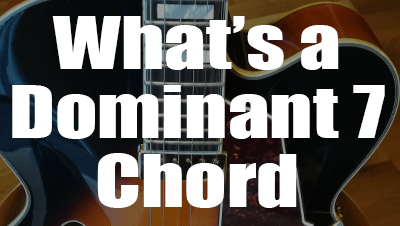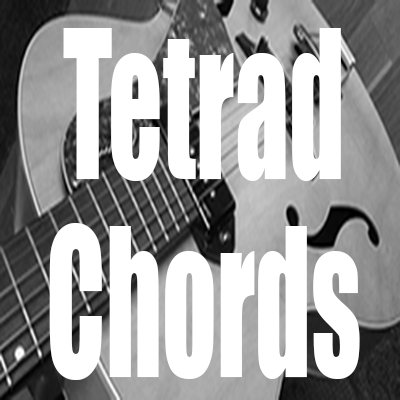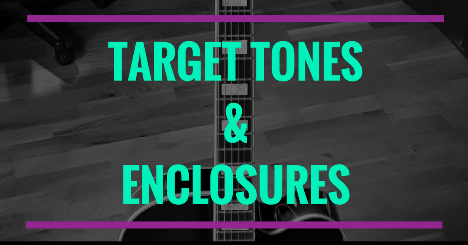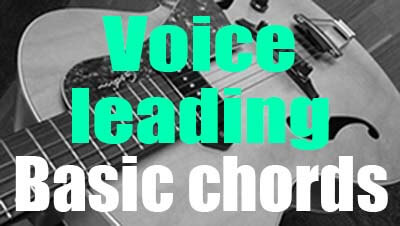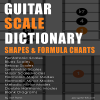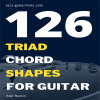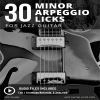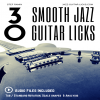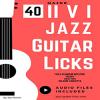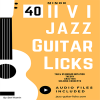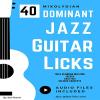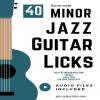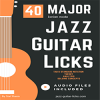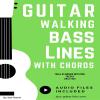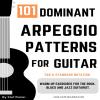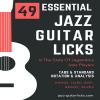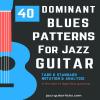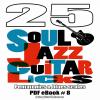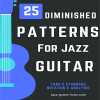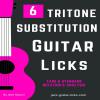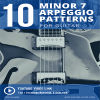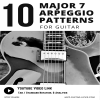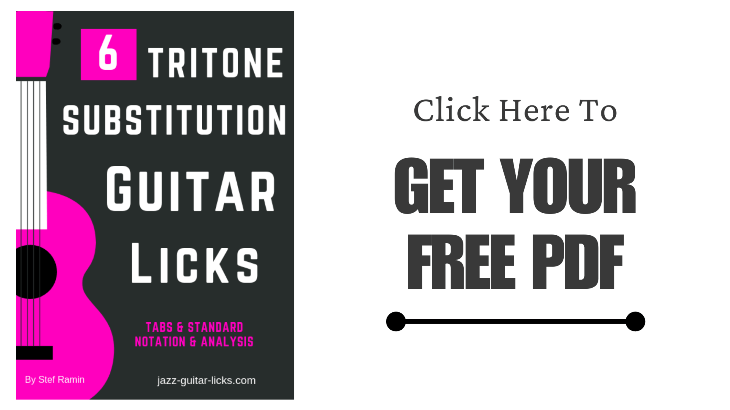Blog - Jazz Guitar Lessons
Welcome,
This blog covers different topics with several useful lessons both for beginners, intermediate and advanced jazz guitar players.
Whether you're looking for tips on playing jazz guitar, this blog surely has the information you crave and will help you expand your music knowledge and technical skills.
Here below many tutorials grouped into several distinct categories:
Jazz Guitar Licks and Transcriptions
Teacher Spotlight - Jazz Guitar Lessons
Cheat Sheets, Methods, Posters, eBooks
The content is regularly updated so don't hesitate to subscribe to the newsletter to receive the latest posts.
-
10 Most Popular Jazz Drummers Of All Time
- By jazz-guitar-licks
- On 2018-10-11
- In Music Reviews
There’s no doubt about it that if you want to be the best at anything, it pays to borrow a page or two from some of the most popular legends before your time. The swing feel is a fundamental aspect in jazz band music, and if you didn’t know, most of that fire in the rhythm comes from the drummers.
Yes, the other instrumentalists such as the pianist, trumpeter, and guitarist may get more attention, but we can’t overlook the importance of the drummer in jazz music. But back to the earlier mentioned idea, who would you look up to as an aspiring, learning, or practicing drummer in a jazz band? Perhaps you might just find your role model in this list, here are the 10 best jazz drummers of all time. Beginyourdrumming.com/ have compiled a list of their favourite Jazz drummers of all time.
-
Triads On Guitar - Lesson With Tabs & Shapes
- By jazz-guitar-licks
- On 2018-10-08
Triads are one of the first harmonic tools to study. They are very useful for comping and chordal enrichment.
Learning close and open (aka spread) triads increase your harmonic knowledge and at the same time help you discover your fretboard.
In this lesson you will see the main triad chord shapes including root positions and inversions.
You will also find some ideas on how to use triads over a II V I sequence, in order to create interesting melodic movement in your comping.
-
What Are Dominant Seventh Chords ?
- By jazz-guitar-licks
- On 2018-09-29
Dominant seventh chords are the most important features in music, you can find them in many styles of music, especially in blues and, of course, in jazz. In this lesson, you will see how to construct drop 2, drop 3 and drop 2 & 4 dominant seventh chords, what is their harmonic function and how to play them on guitar.
-
Tetrad Chords Infographic - Drop 2, Drop 3 and Drop 2-4 Voicings
- By jazz-guitar-licks
- On 2018-09-24
- In Infographics
This guitar infographic enables to learn in a fun way the five main most important chord types found in music thru three kinds of voicings : Drop 2, Drop 3 and Drop 2-4.
-
Jazz up Your Blues - Guitar Lesson
- By jazz-guitar-licks
- On 2018-09-22
- In Guest Posts
 One of the most daunting shifts for any guitarist can be entering the world of jazz guitar. We’ve all read essential jazz guitar books, tutorials and watched videos by those in the know and it’s a vast world full of new theoretical and practical concepts.
One of the most daunting shifts for any guitarist can be entering the world of jazz guitar. We’ve all read essential jazz guitar books, tutorials and watched videos by those in the know and it’s a vast world full of new theoretical and practical concepts.
Most guitar players get into playing through rock/blues and find jazz later on their ability spectrum. If you understand blues, you can start to make some small changes which will add a jazz dynamic to your playing. In this lesson we will cover some of those small changes you can integrate into your playing today. -
Drop 2 & 4 Chords - Advanced Guitar Voicings
- By jazz-guitar-licks
- On 2018-09-14
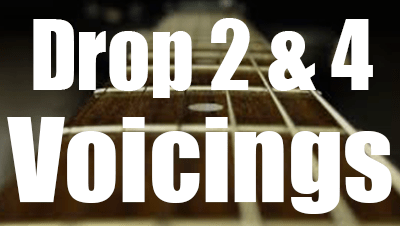 What Are Drop 2-4 Chords?
What Are Drop 2-4 Chords?Drop 2 and 4 chords are created by dropping down an octave the second and fourth note of a seventh chord in close position. They can be very important tools for composition and arrangement. This lesson with diagrams provides useful explanations on how to build and play drop 2 & 4 chords on guitar.
-
Tetrad Chords / Seventh Chords - Music Theory with Guitar Shapes
- By jazz-guitar-licks
- On 2018-09-11
What's a Tetrad ?
A basic chord is built with three notes this is what we call "triad chords" or "triads". Tetrad chords aka "four note-chords" or "seventh chords" are simply chords containing four notes, “tetra“ is a Greek root meaning four. Tetrads can be seen as triads with an additional note which can be a major seventh (7) or a minor seventh (b7).
-
Arpeggio Practice - Seventh Chords - 4 Essential Exercises
- By jazz-guitar-licks
- On 2018-09-09
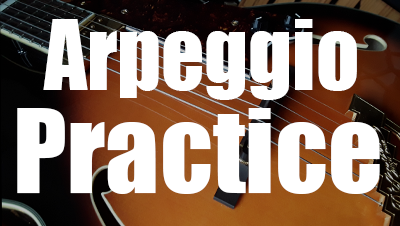 Arpeggios are essential musical tools that allow you to build pure and beautiful lines while highlighting the harmony. When playing over chord changes, using arpeggios is the most efficient way to connect these chords together.
Arpeggios are essential musical tools that allow you to build pure and beautiful lines while highlighting the harmony. When playing over chord changes, using arpeggios is the most efficient way to connect these chords together.This lesson provides four exercises with tabs, standard notation and diagrams that will help improve your guitar skills and your theoretical knowledge.
-
Modes of the Major Scale and Related Chords - Guitar Infographic
- By jazz-guitar-licks
- On 2018-07-24
- In Infographics
This infographic provide guitar shapes that will help you to make the link between the seven modes of the major scale and their related drop 2 and drop 3 chords.
-
List and Comparison of Music Scales
- By jazz-guitar-licks
- On 2018-06-25
Here is a list of the main musical scales and modes.
-
49 Licks of Legendary Jazz Musicians for Guitar - Lessons in PDF with TABS and analysis
- By jazz-guitar-licks
- On 2018-06-04
- In Jazz Guitar Lessons
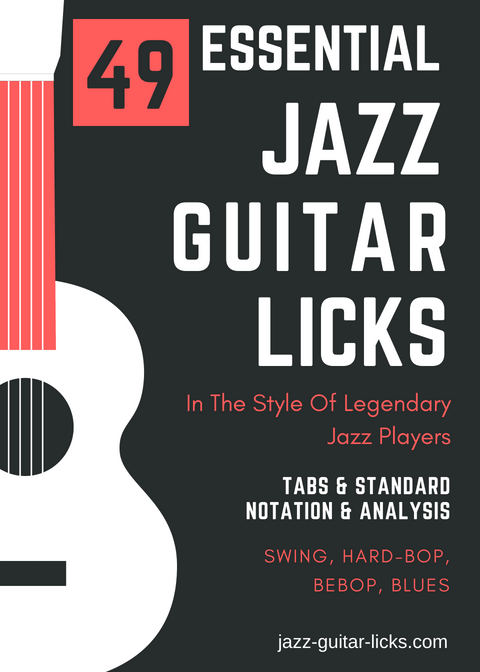 49 Essential Jazz Guitar Licks With Tabs and Analysis
49 Essential Jazz Guitar Licks With Tabs and AnalysisSecure payment by Gumroad / paypal
Practicing jazz guitar licks is a very important aspect of jazz learning. Particularly when these licks are transcribed from improvisations of the greatest jazz musicians of all times (Cannonball Adderley, Barney Kessel, Sonny Rollins, Charlie Christian, Emily Remler, George Benson, Grant Green, Herb Ellis, Jim Hall, Jimmy Raney, Joe Pass, John Scofield, Kenny Burrell, Charlie Parker, Mike Stern and Wes Montgomery) who helped forge the history of jazz music.
This eBook available for download in a PDF format contains 49 effective jazz guitar phrases and patterns with TABS and notation applied to common jazz chord progressions . These patterns both for guitar teachers and students cover different styles from swing to blues, to hard-bop to bebop.
These essential jazz lines arranged for jazz guitarists from beginner to advanced come with easy-to-understand explanations of one of the greatest players improvisational techniques.
Learning these jazz transcriptions make it possible to understand the approach of the great names of jazz to different chord progressions found in many standards as turnarounds, minor and major II-V-I, blues progressions, modal playing.
-
Target Tones and Enclosures - 58 Guitar Patterns
- By jazz-guitar-licks
- On 2018-05-20
- In Jazz Guitar Lessons
This guitar lesson is about a very important concept used by many jazz improvisers named "Target notes" or "target tones" or "approach notes". It has to do with targeting chord tones by scale or chromatically.
This technique opens the door to another essential type of targeting called "Enclosures" used to surround a chord tone both diatonically and chromatically from above and below.
Understanding and applying "Targeting" will help you solos sound more jazzy and allow you to expand your harmonic knowledge.
-
Dominant 7 Chord Altered Extensions - Guitar Infographic
- By jazz-guitar-licks
- On 2018-05-01
- In Infographics
Dominant 7 Chord Altered Extensions - Guitar Infographic
-
Drop 2 Guitar Chord Shapes - Infographic
- By jazz-guitar-licks
- On 2018-04-29
- In Infographics
This infographic with guitar freatboard diagrams show how to play all five types of drop 2 chords on the first set of strings (E, B, G and D strings).
-
Harmonized Major Scale For Guitarists With Shapes
- By jazz-guitar-licks
- On 2018-04-27
- In Infographics
This infographic with three neck diagrams is a useful reminder for beginner guitarists and composers. It shows how to build a drop 2 seventh chord from each note of the major scale.
-
Voice Leading For Guitar - 5 Easy Exercises
- By jazz-guitar-licks
- On 2018-04-24
- In Chords / Voicings
"Voice leading" is a term that refers to the smooth progression of each voice of a chord.
This technique consist to move individually one or several voices up or down by a step from one chord to the next.
This is very used by composers and improvisers in order to connect chords instead of bouncing them around.
The aim of this lesson is to connect or voice-lead basic four-note chords of the same types by moving only one voice.
This should help you learn some of the most important chords used in jazz guitar.
-
Guitar Chord Dictionary
This PDF eBook provides over 550 guitar chord shapes. This is the perfect reference guide to understand how chords are built and how to play them on the guitar neck. -
Guitar Scale Dictionary
This E-book is a printable PDF method including over 700 scale diagrams and formula charts for guitarists. -
Harmonized Scales For Guitar
Complete guitar PDF on harmonized scales: major, minor, harmonic and melodic. Includes chord and arpeggio diagrams, charts and practical tabs. -
172 Arpeggio Shapes For Guitar
This printable PDF is a method dedicated to guitarists of all styles who want to learn build and play the most important types of arpeggios. -
126 Triad Chord Shapes
This handbook for guitar players is intended both for teachers and students. It includes 126 guitar shapes for mastering triads. -
Harmonic Major Scale Chords
this PDF offers diagrams and tabs for guitar to learn the chords of the harmonic major scale. -
Major Scale Harmonization
This package provides a printable PDF with exercises and audio files to learn how to harmonize the major scale with 3 note chords and their extensions. -
30 Minor Arpeggio Licks
This package includes a printable PDF method containing 30 exercises with tabs, staves and audio files for practicing minor arpeggios on guitar. -
II V I Bundle - 170 Exercises
This bundle contains 4 PDF methods for a total of 170 exercises with tabs, staves, analysis & audio files for practicing scales, arpeggios licks & chords over the 2-5-1 progression. -
Diatonic Licks Bundle
This package contains 120 jazz guitar lines based on diatonic modes as Mixolydian, Dorian and Ionian. PDF format with tabs, audio files and analysis. -
30 Groovy Jazz Guitar Licks
This downloadable package contains a PDF WITH audio files giving access to 30 groovy guitar phrases mixing jazz, blues and funky licks for beginners. -
30 Smooth Jazz Guitar Licks
In this package you'll get a printable PDF Method with tabs, notation, analysis, scale shapes and audio files for practicing 30 smooth jazz guitar licks. -
40 II V I Jazz Guitar Licks
This pdf method for guitar contains fourteen 2 5 1 jazz guitar lines with tab, standard notation, analysis, scale charts and audio files. -
50 II-V-I voicings
This printable PDF guitar method provides 50 exercises with audio files, analysis, tab and staves for learning major 2-5-1 chord voicings. -
40 Minor 2 5 1 Chord Voicings
This PDF method contains 40 exercices with tabs, scores and audio files for practicing jazz guitar chords over the minor 2 5 1 progression. -
40 Minor II V I Licks
This guitar method is a printable PDF with tabs, diagrams, theory and audio files providing 40 minor 2 5 1 jazz patterns. -
40 Mixolydian Jazz Guitar Lick
PDF guitar method with tabs, audio files and theory providing 40 dominant jazz guitar lines for teachers and students. -
40 Minor Jazz Guitar Licks
This printable guitar method in PDF format contains 40 easy minor jazz guitar lines based on the Dorian mode. -
40 Major Jazz Guitar Licks
Printable PDF eBook method containing 40 major jazz guitar licks with tab, standard notation and audio files for beginners and intermediates. -
Guitar Walking Bass Lines
This jazz guitar method about walking bass lines and chords is available as a PDF files containing 35 exercises with tabs, analysis and audio files -
101 Dominant Arpeggio Patterns
This printable PDF method provides 101 dominant arpeggio exercises with tab, theory and standard notation for the jazz, blues and rock guitarist. -
49 Essential Jazz Lines
This printable eBook method in PDF format provides 49 jazz solo transcriptions of the greatest jazz musicians. Tab, standard notation, audio files & analysis. -
11 Jazz Blues Studies
11 jazz blues chord studies with tabs, standard notation, analysis, and audio recordings and PDF. -
10 Easy Fingerstyle Blues
This PDF with Tabs and audio files provides 10 easy acoustic fingerstyle blues guitar studies for kids and beginners. -
25 Altered Jazz Guitar Lines
This PDF eBook method contains 25 altered jazz guitar licks with tabs, patterns, scale charts and audio files to master, apply and develop the altered scale. -
40 Blues Dominant Patterns
This printable method is available as a PDF file containing 40 easy dominant jazz-blues guitar lines with tabs, standard notation, analysis, audio files and scale charts. -
25 Pentatonic Licks
This jazz guitar method is an eBook available as a PDF with standard notation, guitar tabs, diagrams, analysis, audio files and backing tracks. You will find in this booklet 25 easy jazz guitar lines with theory using common and rare pentatonic scales. -
25 Soul Jazz Guitar Licks
You will find here an eBook available in PDF containing 25 soul jazz and hard bop guitar licks in the style of Grant Green, Melvin Sparks, George Benson. -
25 Diminished Patterns
This eBook PDF with audio files contains 25 dominant diminished jazz guitar patterns using the half-whole diminished scale and diminished 7th arpeggios. -
6 Tritone substitution licks
This Printable PDF eBook available for free download contains 6 easy jazz guitar licks with tabs/notation, youtube video link and analysis about the tritone substitution. -
10 Minor 7 Arpeggio Patterns
This printable PDF eBook offers 10 easy minor 7 arpeggio patterns with its related YouTube video for beginner guitarists. -
10 Easy Major 7 Arpeggio Licks
This is a printable PDF for beginner jazz guitar players providing 10 easy licks to practice major 7 arpeggios. -
10 Chord Melody Lines
Within this package, you'll discover a set of ten chord melody exercises for beginners. Printable PDFaudio files, a backing track, and a link to the associated YouTube video. -
10 Minor Blues Scale Licks
You'll find here a PDF with 10 easy jazz guitar licks to practice the minor blues scale on guitar.

